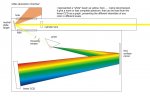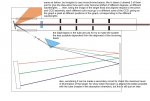HIMNL9
0
- Joined
- May 26, 2009
- Messages
- 5,318
- Points
- 0
Well, as DIY maniac, i always wondered if a DIY spectrometer can be built, without have to manage with variable resonant cavities, etalon assemblies and multipass cells, and without get a nerve chrisis each time you have to realign something  .
.
After some experiments and fails (as usual ), i got something similar to a spectrometer (that, at the present time, looks more as a spectroscope
), i got something similar to a spectrometer (that, at the present time, looks more as a spectroscope  ), without have to sell a lung and an eye for buy a commercial CCD one
), without have to sell a lung and an eye for buy a commercial CCD one 
But it need to be improved a lot, for have some utility ..... decided to share the idea and pre-plans, so maybe someone can have some better ideas (only the draws for now, cause the flying assembly, for now, is a mess that resemble more the result of the explosion of a frag grenade in a spare parts box, than an instrument ).
).
It's based, actualy, on a prism (i had it in a tire ), that decompose the color components of the target image plate, focused through an objective ..... the decomposed beam bounce on a first surface mirror (for double the optic lever), and hit a scan-type linear CCD (took out from a scanner, i have some of them lying around
), that decompose the color components of the target image plate, focused through an objective ..... the decomposed beam bounce on a first surface mirror (for double the optic lever), and hit a scan-type linear CCD (took out from a scanner, i have some of them lying around  )
)
the input for the beam is a diaphragmed tube, with a non-reflective (matte) neutral plate at the end, turned in the opposite sense respect to the reading assembly, for try to avoid any direct reflex interference (that are "trapped" in an "absorption chamber" ..... sorta of ), and with a cylinder lens in front of the target plate, for project a line on it (it's much more easy have to work with a vertical line, when you have to make alignments on an horizontal plane, than that with a dot
), and with a cylinder lens in front of the target plate, for project a line on it (it's much more easy have to work with a vertical line, when you have to make alignments on an horizontal plane, than that with a dot  ) ..... i choosed this system, also if it's not too much sensitive, for avoid to have to pass half of the time just aligning the input beam with references ..... reading the image of the beam on the surface, when the surface is already aligned with the rest and kept fixed in place, just require you to align the beam with the input tube, instead align it also with the references of the lenses and the CCD sensor.
) ..... i choosed this system, also if it's not too much sensitive, for avoid to have to pass half of the time just aligning the input beam with references ..... reading the image of the beam on the surface, when the surface is already aligned with the rest and kept fixed in place, just require you to align the beam with the input tube, instead align it also with the references of the lenses and the CCD sensor.
The output of the CCD sensor is just connected to an oscilloscope, with a circuit that give it the trigger for scan cycle, and at the same time a trigger signal for the scope ..... this way, you just see the spectrum as a graph on the screen, with peaks corresponding to the position of the illuminated pixels (and to the different wavelenghts) ..... let say, most of the times, it works, but is unstable, perhaps i have to make some better triggering circuit, more stable ..... all is closed in a dark box.
Actually it works (more or less), but give, imho, not too much deviation, from red to BR, it vary approximatively 1 cm ..... the linear CCD can read almost 5 cm, at least the better one i have here ..... need to find a way for get more diffraction than with just a prism ..... i had two different ideas, the first one is to add another pair of first surface mirrors, made the beams bounce more, making the path of the diffracted light more long and in this way increasing the distance of the single lines, but this can cause me more alignment problems too, and can make all the assembly also less sensitive ..... or, find something more efficent of a prism, for diffract the beam ..... was wondering about those glass diffraction gratings that are used in labs, but they costs a lot (700 lines/cm or better, need to work linearly from red to blue and more, and usual cheap 200 lines ones that are sold as laser effects or "fireworks eyeglasses" are not working good for all the wavelenghts ..... the better choice can be an UV-rated grating, but at this point i suspect that can be more cheap just buy an already-ready CCD-based spectroscope ) ..... the blu-ray ones that you can find in sleds like phr are good, but too small, and causes a lot of alignment problems ..... need to find something better.
) ..... the blu-ray ones that you can find in sleds like phr are good, but too small, and causes a lot of alignment problems ..... need to find something better.
Also, for the target, i used a piece of aluminium sanded plate, cause at least half of the things i tried had some fluorescence that appears in the spectrum, when i was trying BR ..... but i have to say that, with the time, it change response ..... probably for surface oxidation, wondering if something anodized can be better, but don't know peoples that can do anodization of aluminium, here.
If someone have some better ideas, or know where to find some good (and cheap) gratings like the one in the BR sleds, but at least 8 / 10mm or more, instead the usual 2 / 3 mm ones, feel free to shoot ..... er, mean, say them

After some experiments and fails (as usual
But it need to be improved a lot, for have some utility ..... decided to share the idea and pre-plans, so maybe someone can have some better ideas (only the draws for now, cause the flying assembly, for now, is a mess that resemble more the result of the explosion of a frag grenade in a spare parts box, than an instrument
It's based, actualy, on a prism (i had it in a tire
the input for the beam is a diaphragmed tube, with a non-reflective (matte) neutral plate at the end, turned in the opposite sense respect to the reading assembly, for try to avoid any direct reflex interference (that are "trapped" in an "absorption chamber" ..... sorta of
The output of the CCD sensor is just connected to an oscilloscope, with a circuit that give it the trigger for scan cycle, and at the same time a trigger signal for the scope ..... this way, you just see the spectrum as a graph on the screen, with peaks corresponding to the position of the illuminated pixels (and to the different wavelenghts) ..... let say, most of the times, it works, but is unstable, perhaps i have to make some better triggering circuit, more stable ..... all is closed in a dark box.
Actually it works (more or less), but give, imho, not too much deviation, from red to BR, it vary approximatively 1 cm ..... the linear CCD can read almost 5 cm, at least the better one i have here ..... need to find a way for get more diffraction than with just a prism ..... i had two different ideas, the first one is to add another pair of first surface mirrors, made the beams bounce more, making the path of the diffracted light more long and in this way increasing the distance of the single lines, but this can cause me more alignment problems too, and can make all the assembly also less sensitive ..... or, find something more efficent of a prism, for diffract the beam ..... was wondering about those glass diffraction gratings that are used in labs, but they costs a lot (700 lines/cm or better, need to work linearly from red to blue and more, and usual cheap 200 lines ones that are sold as laser effects or "fireworks eyeglasses" are not working good for all the wavelenghts ..... the better choice can be an UV-rated grating, but at this point i suspect that can be more cheap just buy an already-ready CCD-based spectroscope
Also, for the target, i used a piece of aluminium sanded plate, cause at least half of the things i tried had some fluorescence that appears in the spectrum, when i was trying BR ..... but i have to say that, with the time, it change response ..... probably for surface oxidation, wondering if something anodized can be better, but don't know peoples that can do anodization of aluminium, here.
If someone have some better ideas, or know where to find some good (and cheap) gratings like the one in the BR sleds, but at least 8 / 10mm or more, instead the usual 2 / 3 mm ones, feel free to shoot ..... er, mean, say them







